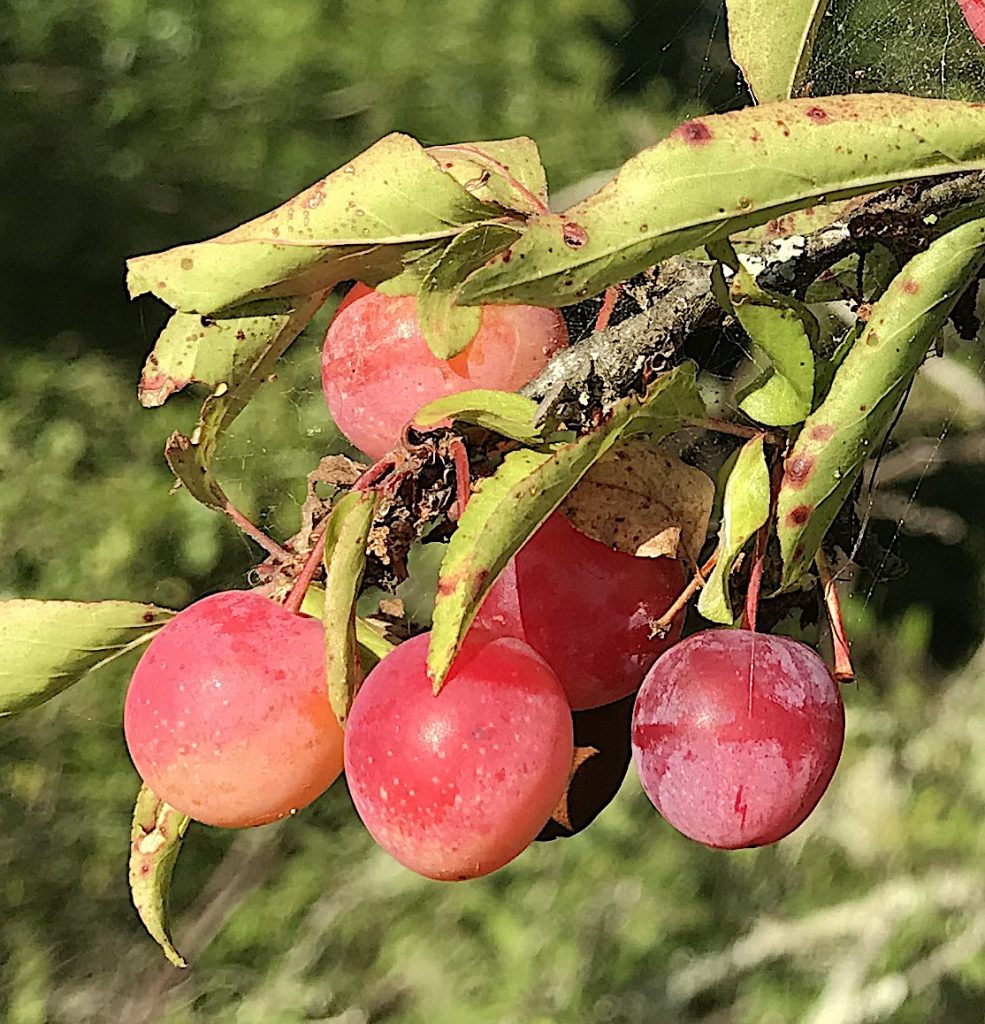
Wild Plums can be as sweet as cultivated plums. Photo by Green Deane
This was a “Prunus” foraging week. While rummaging around Ocala we saw Chickasaw Plums. They are still green and sour and should be ripe in a month to six weeks. Black Cherries are also ripening but are often more difficult to find because the birds also like them. Cherries and plums are in the same genus, Prunus, so it’s not surprising they are ripening at about the same time. Also setting fruit are the Flatwood Plums but they are different story and are included in my related article. I have a video on the Chickasaw plum here, Black Cherry here. To read about the Black Cherry go here, the Chickasaw Plum, here.
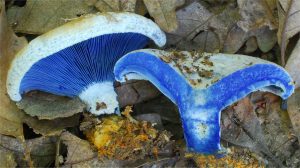
The Indigo Milk Cap is edible and easy to identify. You’ll find them for several months.
It’s been a strange week for edible wild mushrooms. Ringless Honey Mushrooms favor the fall but the right weather conditions in the spring — rain in April or May and cool weather — can cause a minor occurrence of them. This week there were sporadic reports of said about the South. I have even seem them on a Banyan in West Palm Beach in July. Also seen this week were a few mushrooms in the Milk Cap group. They all used to be Lactarius. Some still are but others were renamed Lactifluus (as if mushrooms weren’t confusing enough.) I saw a couple of hot Milk Caps this week — hot as in peppery — and also the one shown left, Lactarius indigo. It is indeed a pretty mushroom and edible though its texture can be a tad grainy. With rains between now and the end of the month the summer mushroom season should get a good start. Hopefully by mid-June the Orlando Mushroom Group (OMG!) can have a forage.
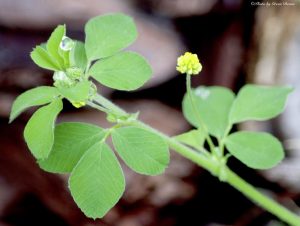
Note the long stem on the middle leaf.
You’re probably seeing a lot of this and wondering what the species is. This little plant with the little yellow blossom is Black Medic. It’s generally considered edible and like many weeds is from Europe. That kind of excludes it from being a significant Native American food (though some sources call it that… It’s a long story.) The headache is that from a distance of about five or six feet (where most people’s eyes are from the ground) Black Medic can look like Hop Clover. Here’s quick way to tell them apart: Hop Clover tends to have red stems, Black Medic has green stems covered with fine white hair and has a longer stem on the center leaf. After the two species go to seed they are easy to sort out: Black Medic has black seeds… hence the name. Hop Clover brown seeds. I personally don’t view Black Medic as much of an edible but you can read more about it here.
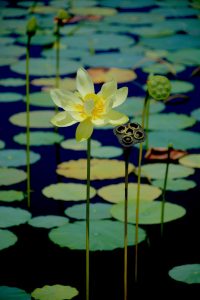
American lostus seeds are choice. Photo by Green Deane
Yellow ponds, that’s how I think of it, or in some places, yellow rivers. That’s because the American Lotus is in blossom. The first time I saw a small lake of these blossoms was when an old dry lake was deepened for a housing development. The next spring suddenly what was for decades a dry lake was full of American Lotus blossoms. This is because the seeds can stay viable some 400 years, or so the experts report. Talk about a survival food! There are multiple edible parts on the American Lotus but I prefer the seeds. I also think when collecting by hand the seeds provide the most calories for the amount of work. The roots are edible but digging them up can be a messy, laborious job because the plant doesn’t suggest there its root is located. Locally American Lotus are easy to find now: Just look for a lake with large yellow blossoms on long stem a foot or more above the water. Further north and west they are a favorite sight on rivers such as the Mississippi. To read more about the American Lotus go here.
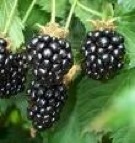
Blackberries are ripening
Acres of wild blackberries... well, perhaps not acres but certainly a lot of them. Where? On the bike trail between Lake Monroe Park and Gemini Springs Park in south Volusia County. That part of the bike trail wends its way for a little over a mile between two parking lots. Look for the powerlines… this same area will also have in a couple of months bushels of Passiflora incarnata, Maypops… along the way to this location on the southern side are many cattails and to the west of Gemini Springs Park (in the cow pasture) there are a lot of Pawpaws. The things ones see while riding a bike. And… if you like to travel by train there is a Sunrail stop (Debary) directly west of the patch (and a path to said on the east side of U.S. 17-92.) As they are wild blackberries they are well armed. And a reminder that foraging is illegal in Florida so proceed stealthily. Why is foraging illegal? Unanswerable officials have to have something to do. If we had a Commissioner of Ants there would be all kinds of ant rules, do’s and don’t’s and fines et cetera. The more government the more rules and the more functionaries to interfere with your life. In theory elected official were supposed to make all the rules and be accountable for all of them. And if we didn’t like the rules or decisions we vote them out of office. But then politicians made unanswerable committees, commissions and departments to make and enforce rules. These add-on bureaucracies do not answer to the people or to the elected officials that created them. If a wildlife commission makes a truly stupid decision and citizens don’t like it, tough. Thus the second rule of foraging is “no witnesses.” The third rule is “eat the evidence.” The first rule of foraging is wash your hands BEFORE you go to the bathroom ’cause you never know what you’ve been touching…
Foraging classes this weekend are in south Carolina. They will resume locally May 14th
Saturday/Sunday May 7th & 8th, Honea Path, South Carolina, classes at 9 a.m. and 1 p.m. each day.
Saturday May 14th Dreher Park, 1200 Southern Blvd., West Palm Beach, 33405. 9 a. m. to noon Meet just north of the science center.
Sunday may 15th, Mead Gardens, 1500 S. Denning Dr., Winter Park, FL 32789. 9 a.m. to noon Meet at the bathrooms.
For more information, to pre-pay or sign up go here
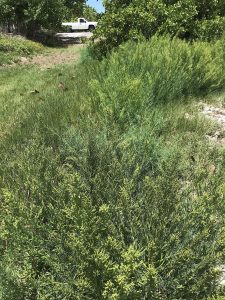
Seeding Seablite. Photo by Green Deane
Saw large amounts of Seablite recenty. Depending where you are in the state it is either starting its seasonal run or close finishing it. An excellent contender for a commercial crop it’s in the Chenopodium family. There was copious amounts of it at Canaveral Seashore National Park. I also saw Sea rocket and Silverhead but the prime edible was Seablite. Curiously on the mainland side of the park some of the Seablite was bitter. It is usually a very mild green edible raw or cooked. You can read about Seablite here or see my video here.
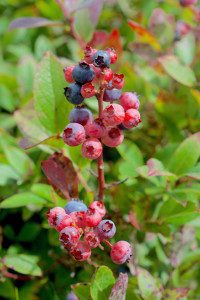
Blueberries, Roan Mt. North Carolina.
One group that is starting to ripen is Blueberries (which can be black.) We saw some in our foraging class Sunday in Wickham Park, Melbourne in a flat wood scrub. Blueberries like soil on the acidic soil, a pH below 7 on a 14-point scale. I grew-up in poor-soil Maine where one could find 120-acre fields of nothing but Blueberries. Yet where I live now, in Florida, Blueberries are found in small colonies in isolated pockets. Why? One answer is Florida is a limestone plate (alkaline not acidic) so it is a waste of time to look for Blueberries unless there are acid-producing pines, oaks or perhaps cypress nearby. I planted Blueberries specifically bred for Florida but one has to tend to the soil — the amount of acid — nearly as much as one has to work daily to keep a pool from turning green. They eventually died, one of my few failures.

You get the USB, not the key.
My nine-DVD set of 135 videos has been phased out and replaced by 171-videos on a 128-GB USB, see left. The USB videos are the same videos I have on You Tube. Some people like to have their own copy especially if social order falters. The USB videos have to be copied to your computer to play. If you want to order the USB go to the DVD/USB order button on the top right of this page or click here. That will take you to an order form. Or you can make a $99 donation, which tells me it is for the USB (include a snail-mail address.) I’d like to thank all of you who ordered the DVD set over the years which required me to burn over 5,000 DVDs individually. I had to stop making them as few programs now will read the ISO files to copy them. Burning a set also took about three hours.

Green Deane Forum
Want to identify a plant? Perhaps you’re looking for a foraging reference? You might have a UFO, an Unidentified Flowering Object, you want identified. On the Green Deane Forum we — including Green Deane and others from around the world — chat about foraging all year. And it’s not just about warm-weather plants or just North American flora. Many nations share common weeds so there’s a lot to talk about. There’s also more than weeds. The reference section has information for foraging around the world. There are also articles on food preservation, and forgotten skills from making bows to fermenting food. Recent topics include: Fermenting potatoeswith yogurt, make a water filter, nixtamalization at home, Stale Bread and Cod Liver Oil, Life’s a Grind, Killing Bugs with Tobacco Plugs, Eating weeds: Is it safe? Have they mutated? Not the Eastern Red Bug but the Pink Tabebuia, African Tulip Tree, Asparagus densiflorus, Green Deane’s Book… You can join the forum by clicking on the button on the upper right hand side of this page.
This is my weekly newsletter #506. If you want to subscribe to this free newsletter you can find the sign-up form in the menu at the top of the page. My website, EatTheWeeds.com, which is data secure, has over 1500 plants on it in some 428 articles. I wrote every one myself, no cut and paste.
On a personal note, my rent is doubling. I need a place to move to. Currently renting a two-bedroom small house. Email Green Deane@gmail.com
To donate to the Green Deane Newsletter click here.

